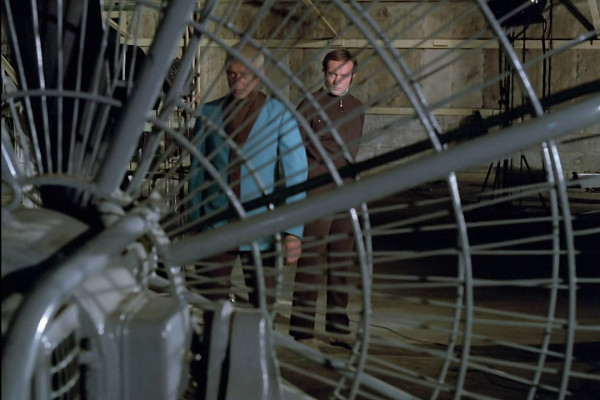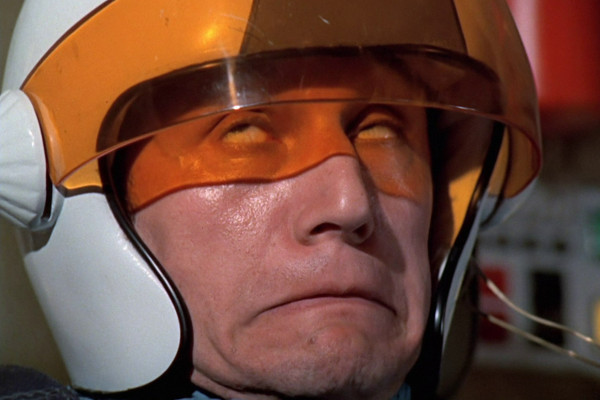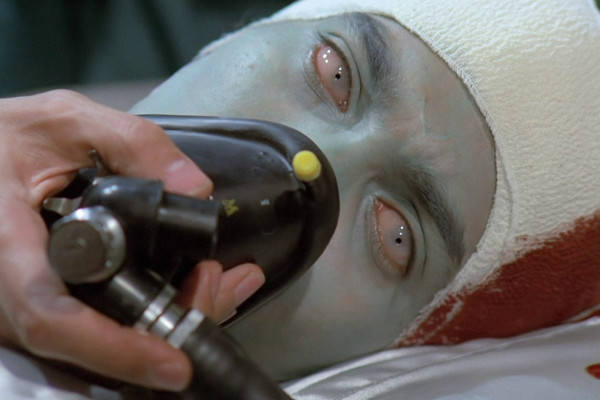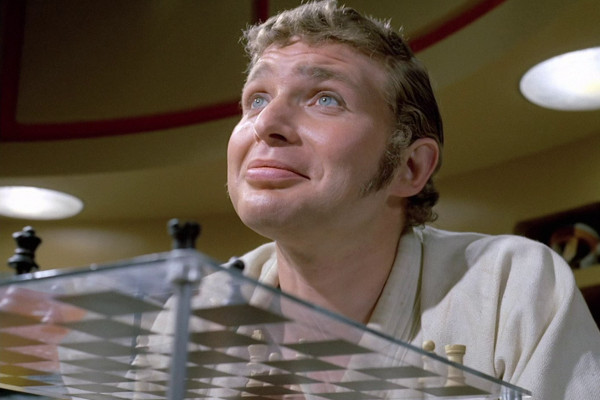


↑ Down 2 Places
Previously highly-ranked, a fresh take on these episodes sees Reflections In The Water drop a couple of places. Often with the Pinewood episodes, they're better directed, but can be more narratively sparse. As a result, the already underplayed emotional content has even less chance to emerge, causing the series to feel oddly clinical. Wanda Ventham (Colonel Lake), while fine, isn't really presented as an equal for a lot of her appearances, and so the three-way combative chemistry that was present with George Sewell is absent, and the programme does feel like it's missing a vital element, even though many Ventham episodes are ranked far higher.
Reflections in the Water is the inevitable doppelgänger episode of UFO, yet doesn't have the budget to present us with a single splitscreen, and so we get the two highest-ranked members of SHADO improbably risking their lives without even the chance to confront "themselves" onscreen. Add to this some appalling slowfighting, sophisticated alien reproductive devices that resemble tape machines and a jazz-funk clips package to start off the episode and the poetically-named Reflections In The Water doesn't seem to add up to a great deal. Even stranger is that the opening montage inexplicably gives away the climax.
Yet there's decent stuff in there, with Straker displaying the increasing desperation, prepared to drug one of his own team to get results, and although SHADO being able to hold off and destroy a mass attack of 25 UFOs does seem to be a stretch, it also shows the increasing desperation of the aliens themselves. Lastly, there's the BluRay release of the series. While the programme has never looked better, the high definition does sometimes uncover some serious sins... such as the little old man, pictured, who plays "Straker" during the fight scenes.

↑ Down 5 Places
One of the big debates about UFO is always what order it should be watched in. The series was bought up by regional networks in the UK and shown in different orders throughout, something very common with a lot of ITC shows where continuity wasn't a major issue. This does make it look as if SHADO has a revolving personnel, rather than half the cast just leaving halfway through, so is, in one sense, preffered. And mixing them up does mean that two of the wittiest and innovative episodes - Timelash and Mindbender - don't follow each other back-to-back as they do in the production order.
However, that production order is preferred in almost all other ways, as the style of the show evolves, and the mix of narrative-driven early episodes clashes badly with more esoteric, stylistic episodes later in the run. The only requirement is that this fifth-produced episode is watched fourth, given that it's the introduction of Michael Billington as Paul Foster, but the second episode he recorded, after Survival. In fact, it's strange to think that while the Straker-Freeman-Foster line-up is the most dramatically compelling, they only appeared together in just over half the episodes.
A functional but decent episode is marred slightly by Paul getting beaten up by two men in polo necks to a lounge jazz theme, UFO once more showing its less credible side. And while Michael Billington brings a lot of presence to the series, his wig is always a distraction, even when it's a shorter one as here. In fact, his wig glue should have received its own credit for the scene where Straker eccentrically tortures him with a big fan.
The story ends with Foster laughing at Straker's offbeat sense of charm, even though Straker has spent most of the episode arranging to have him beaten up, or letting him think he's going to shoot him dead. Paul Foster, it seems, is just one of those happy-go-lucky guys who never holds a grudge. Watchable stuff, although, unlike the best of UFO, there's never really any sense that the story will go in an area you didn't expect.

↑ Down 2 Places
The curious part of reviewing a series is, of course, personal expectations. Sometimes a favourite episode won't contain much rewatch value, whereas a duller, more run-of-the-mill story might have more to enjoy the second or third time around. While The Sound of Silence hasn't fallen as much as some, its drop out of the top ten does say more about how it stands up to repeat viewings rather than its own intrinsic qualities.
The episode itself was written by a pair of directors, and so relies more on mood and visuals than the dialogue. As a result its narratively thin... still strong enough for a high ranking, but not as narratively interesting as some entries which have weaker direction but stronger plots. Often esoteric, it features such off-kilter characters as a woman who jokingly suggests she skinny dip with her own brother, and a hippy and his dog who end up mutilated. The brother and sister (Michael Jayston and Susan Jameson) appear on the BluRay documentary, "From Earth to the Moon", and reveal that the moment where Jameson is thrown from her horse was actually unplanned and really happened.
The first seventeen episodes of UFO were filmed at MGM Borehamwood from April-November 1969. After the closure of the studio, the remainder of the series was picked up in Pinewood studios from May 1970, starting with this one. These final nine episodes are often darker, stranger, and even more adult, and are a nice compliment to the series. Most notable in the second recording block however is the loss of several lead characters. As the actors involved weren't in contract and had offers to appear elsewhere, then many faces disappear without onscreen explanation, most notably Colonel Freeman and Gay Ellis. Freeman, in particular, acted as Straker's confidant and conscience, and his absence can be felt.

↓ Up 3 Places
Destruction is the most engaging of the "procedural" episodes of UFO, where the script isn't so concerned with overt action, but instead boardroom politics, diplomatic negotiations and red tape. Essentially working as a detective story, SHADO discover that deadly gas has been dumped into the sea, which is being targeted by aliens to destroy all life on Earth. It's an intriguing concept, with little bits of trivia like the knowledge that Moonbase has only been in existence for 5-6 years at this point. In all, it's a reasonably layered episode that is notable for far more than acclaimed actor Steven Berkoff pulling an unintentionally funny face as an Interceptor pilot.
One thing frequently mentioned when discussing UFO is that Gerry Anderson's first non-puppet effort was the feature film Doppelgänger (1969), which featured many of the same costumes, sets and music cues as UFO. More significantly, it also starred no less than 14 performers who went on to appear in UFO, including Ed Bishop, George Sewell and Vladek Sheybal.
Released outside the UK under the far less spoiler-insensitive title of Journey to the Far Side of the Sun, it's a watchable albeit ultimately unsatisfying effort. Some of the actors from it who appeared in this particular UFO episode are Jon Kelley (Skydiver Navigator, uncredited in the movie), Alan Harris (uncredited here as Skydiver Engineer) and Philip Madoc (Ship Captain).

↓ Up 7 Places
A very high number of television series have issues with their opening episodes, and UFO is no exception. Although it is, in retrospect, a lot better when you're used to the series, and finally scrapes into the top ten here, it's not a particularly striking introduction to the concept, and even creator Gerry Anderson acknowledges his own direction lacks pace.
There is the feeling that the show isn't quite there yet, with George Sewell as Colonel Freeman walking around muttering sub-Bond innuendo and being incredibly lucky that SHADO doesn't have a HR department that can investigate sexual harassment. Although the only nipples we see belong to the string-vested men aboard the underwater Skydiver, there is also too much of the camera having a "wandering eye" when it comes to the female form.
Anderson recorded a commentary track for the episode, and isn't backward about this aspect of his personality, explaining that he thought Gabrielle Drake was "absolutely stunning" and that "I found her... extremely... attractive. I used to tell everyone about this. Except my wife, of course." It shows. A scene where Drake is lazily applying lipstick in the middle of a yellow alert situation is incredibly demeaning to the character.
The worst moments come with Ed Bishop being forced to tell one of his security team the entire basis of the series, something he'd already know, but exposition is always a necessarily evil in opening stories. There's always a certain amount of inherent cheesiness in UFO - it is, after all, a series that features purple wigs and a lounge jazz soundtrack - but things pick up in the closing moments when we attend a funeral for a woman whose organs were harvested by aliens. It's not an opening episode to get you hooked, but it is one that can be appreciated on repeat viewings.

↓ Up 10 Places
The Man Who Came Back was previously slated in this ranking, where my main issue way back in 2013 seemed to be that it revolved around characters unfamiliar to the viewer. To an extent, it's true. There's Colonel John Grey, a high-ranking member of SHADO who even covers for Straker, played by Gary Raymond. (Raymond was reportedly due to play Colonel Lake before they changed the gender of the character and, in an odd coincidence, one of his first jobs after the series was playing a character called "Paul Foster" in The Doctors).
The other new character is Colonel Craig Collins, played with the usual scene-stealing presence of Derren Nesbitt. Nesbitt's performance may be a little more showy than the somewhat clinical turns of the regular cast, but with him strutting around Moonbase like a preening peacock, charming everyone with a bottom lip like a cumberland sausage, he's a real fun addition to what could otherwise have been a pedestrian "alien control" plot.
Although made over a year after Flight Path, another episode with a guest character who is known to the regulars but not to the viewers, they were screened in consecutive weeks on ATV. It makes an odd pairing, but does also undermine my prior complaints with the episode, given that I seemingly had no such issues with Flight Path.
The only real weakness here is the Shatnerism of Straker's "they can never get your soul", and the admittedly curious relationship that Lake had with Collins, and the burgeoning one she has with Paul Foster - neither are mentioned in the series again. Lastly, lovers of Mary Whitehouse-related trivia might note that this is the only UFO episode with swearing in it, as Colonel Grey demands a "bloody telephone!"
As with Kill Straker!, the episode Timelash had a commentary track for a 2003 American DVD release that was later licensed for an Australian release, but not the UK ones. The reason for its mention here is that commentators Wanda Ventham and Sylvia Anderson don't discuss much of note about the episode they're commenting on (save for a reference to Patrick Allen needing a jockstrap), but do reference this one quite a bit.
As the discussion moves on to actors that were "difficult", then Alexis Kanner from The Cat With Ten Lives gets brought up, while this episode's Derren Nesbitt is described by Ventham as "renowned for being dangerous to have around". While both say he was fine when it came to the recording of the episode itself, Ventham says she was particularly untaken with the kissing scene, given that it was early in the morning, it was scripted as a firm kiss, and Nesbitt's breath smelt of smoke. SHADO Radio Operator Tamara Paulson (Anouska Hempel) also gets mentioned for her part in this and three other episodes, as Sylvia Anderson notes "she had an attitude, didn't she?"
Lastly, Ventham confirms that Raymond auditioned for her part, and, despite George Sewell's claims that he left the series because production closed down for five-and-a-half months and he'd got work elsewhere, Sylvia repeats another version of events that has done the rounds - that the American backers asked for him to be removed as they felt he wasn't good-looking enough to be in the series. Poor old George.

↑ Down 2 Places
There's suggestions that, had a second season of UFO been made, it would have featured less "domestic", Earth-bound episodes, as these were less popular in America where it was originally a hit. It's a shame, because it means most of the higher-rated episodes here wouldn't have made it to a second run.
There's no model cars or purple wigs here; while the love scenes between Straker and his wife can be a little syruppy, it's a perfect character study of the show's troubled lead. Featuring great ironic foreshadowing (Straker and Henderson begin the story as great friends) and showcasing the breakdown of Straker's marriage, it also tells the full story of the origins of SHADO.
Script editor Tony Barwick was the most prolific writer on the series, being credited with a dozen of the teleplays in the series. What's shocking is how the same man can be behind such a wide variance in quality: the same person who gave us Mindbender, A Question of Priorities and this episode also crafted Close Up, The Responsibility Seat and Ordeal. But if UFO's lack of quality control is all part of the fun, then Confetti Check A-O.K. is one of the peaks.
In 1974 a compilation movie was released, titled Invasion: UFO. While it was mainly made up of around half an hour each of Identified, Reflections in the Water and Computer Affair, other episodes made up smaller bridging sequences, such as around a minute of The Man Who Came Back and ESP. Confetti Check-A-Ok had around five minutes of footage used for the film, and, whatever the relative merits of the movie, the footage from this episode was well implemented, as it explains immediately what happened to General Henderson after the car crash in Identified, rather than keeping viewers waiting ten months to find out. In fact, the two segments go so well together it's surprising they weren't part of the same episode.